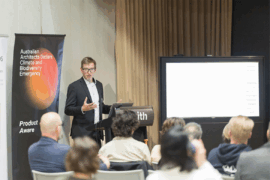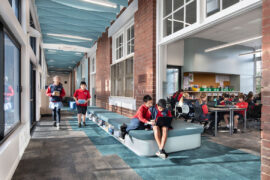On the eve of his promotion, Bates Smart Director Brenton Smith speaks on the recipe for creative intelligence that keeps the practice at the top of its game.
After six years with Bates Smart, building the Sydney interiors design studio to a streak of acclaimed projects including Corrs Chambers Westgarth, the InterContinental Hotel and OneThirty Hyde, Brenton Smith was a natural choice for the role of Director. Accordingly, his transition into it has been seamless. As he puts it, “On a day-to-day level, not a lot has changed. Which I think is the right way to be, because with a lot of change it makes you wonder whether it’s the right appointment, right?”
Smith seems less interested in the circumstances and reasons for his promotion than he does in the values of the practice he now leads, however, and is irrepressible regarding them. “What we like doing the most is collaborating and producing Bates Smart architecture and interiors that make the project one holistic product,” he says.
“On integrated projects, we foster a lot of creative intelligence early on. That’s our main objective. When we do that, we find that we’ve got a very considered approach.”
This creative intelligence, according to Smith, “crafts a story. It crafts a response. It crafts everything, from an outcome from the envelope and the massing of the building, to the way you see people inside the space and how it evolves.” The consistency of this story throughout a project is the signature of Bates Smart’s pairing of the capabilities of a fully-fledged architecture firm with the capillary attention to detail of a bespoke approach; what Smith playfully calls ‘Big Boutique’.
To achieve this, Bates Smart astutely deploys its primary asset: its staff. For instance, the practice has a policy of rotating teams through different typologies. Smith expands, “One day, a team may be working on the Four Seasons. The next thing you know, they may be working on a legal firm. That agility and flexibility helps us bring to market things that are sometimes a little bit different—not quite as stereotypical as what you’d expect if the same team worked on the same kind of projects all the time.”
The policy applies at all levels, with the practice’s structure eschewing the traditional divisions into departments for commercial, hospitality, residential, etc. At the top, Smith leads Sydney’s interiors practice across all project types: “Our structure gives me opportunities to understand different market nuances, different client profiles. It gives me a broader range of design outcomes, which is kind of unique. I don’t think there are a lot of top level architects that run across that many different sectors. I like this approach.”
Bates Smart also invests in keeping its staff informed, stimulated, and inspired. The practice regularly commissions white papers on various industry issues, for example. “That kind of granular research—deeply examining how the sectors we’re studying are working—really jumpstarts ideas about how they can be improved,” reflects Smith. The Bates Smart team then look to other creative mediums for inspiration: “Particularly with interiors, we look to a whole lot of different industries for design creativity. Looking at fashion, industrial design, and other fields that are highly creative and detailed is another really good way to stimulate ideas and examine materiality from a different perspective. We can then bring those ideas into workplace, hospitality, leisure, and all other kinds of projects,” Smith explains.
Also, and crucially, given the realities of demanding clients and punishing deadlines, the practice keeps a close eye on the wellbeing of its employees, encouraging a strong internal design culture and the pursuit of individual projects. This tradition was most recently illustrated by Nancy Ji, a Bates Smart designer who won the 2016 Mercedes-Benz Design Award for her Lily Tray Table, now part of Tait furniture’s collection. “We are incredibly supportive of people who want to discover and push their talent outside of the office,” Smith says. “I believe, personally, that this is key to cultivating Bates Smart’s strong design attitude and culture.”
As a result, Bates Smart has evolved and maintained a versatile, committed team abreast of the latest developments both within their field and across the creative industries, uniquely positioned to offer exceptional design responses. Or, in Smith’s words, “Over the last 150 years, the practice has remained so robust and resilient because we have made sure that it’s a highly refined product. It’s very well crafted. We’re still very much about that finesse.”
.
INDESIGN is on instagram
Follow @indesignlive
A searchable and comprehensive guide for specifying leading products and their suppliers
Keep up to date with the latest and greatest from our industry BFF's!

A longstanding partnership turns a historic city into a hub for emerging talent

London-based design duo Raw Edges have joined forces with Established & Sons and Tongue & Groove to introduce Wall to Wall – a hand-stained, “living collection” that transforms parquet flooring into a canvas of colour, pattern, and possibility.

In a landscape clouded by data and greenwash, Product Aware offers architects and designers a common language for sustainability. Embraced by suppliers – including Milliken – it is setting a new benchmark for trust and bringing clarity and accountability to material specification.

The shared Melbourne office brings together Studio 103 and McCormack in a dual headquarter that doubles as a showcase of materials and craft.
The internet never sleeps! Here's the stuff you might have missed

At Moonee Ponds Primary School, Clarke Hopkins Clarke’s transformative design uses Autex acoustic solutions to shape a calm and creatively charged learning environment.

Saturday Indesign lit up the CBD and South Melbourne with design, wellness, hospitality, and community in a day full of creativity and connection.